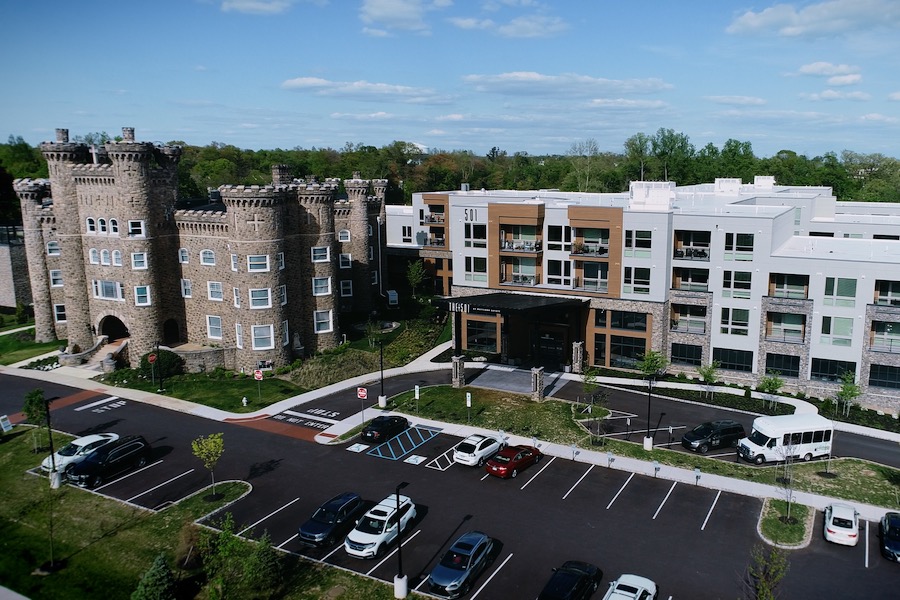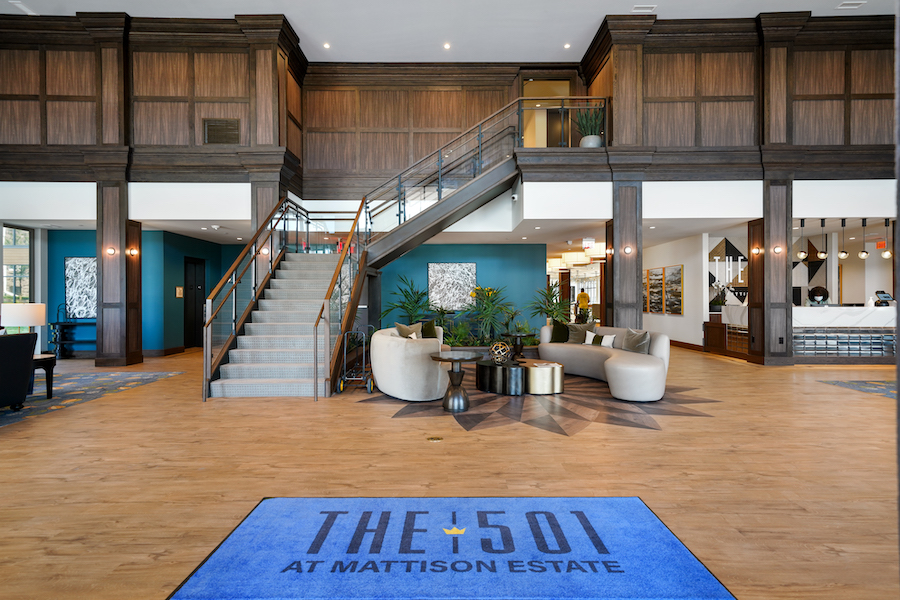Need a Place for Mom and Dad? Here, They’ll Live Like They’re On Vacation
The 501 at Mattison Estate offers its residents maximum choice and flexibility. And if their life situation changes, they can move out with no further obligation.

Once a home for at-risk youth and now awaiting its next future, Lindenwold Castle in Ambler (left) has a new neighbor: The 501 at Mattison Estate (right), a new luxury senior living complex with the amenities and ambiance of a luxury resort hotel. / This photo by Todd Ballantyne; other photos as noted; all photos via SageLife unless otherwise noted
Chances are that by now, you’ve heard someone refer to a nursing home or senior living facility as “God’s waiting room.” In fact, an entire state has been called that.
And as it is, the way most senior living communities operate, their owners and managers assume that the next move a resident will make once they move in is off this mortal coil. That’s because most senior living communities function as condominiums: One buys one’s residence when one moves in. The buyer pays a large upfront fee to cover services they may need down the road and makes monthly payments towards the purchase price, the same as they would have if they took out a mortgage.
If a resident decides to move out, they have to either keep making payments or sell their unit. Or, if they do indeed die in the facility, their heirs have another asset they will need to dispose of.
SageLife, which owns the 501 at Mattison Estate on the edge of Ambler, operates differently. Here, as at their other five communities from Massachusetts to Maryland, residents can move in when they want and leave when they want with no obligation because they’re tenants rather than owners. And the upfront fee may be no more than the usual three months’ rent one pays when moving into a luxury apartment.
“There’s a small upfront fee, like $5,000 to $10,000, depending on the community,” says SageLife president Kelly Andress. “And then you just pay your monthly rent as you go. And it’s a month-to-month lease, giving you optimal flexibility.”
Flexibility is also the keyword in describing how SageLife runs its supportive care communities for seniors. While SageLife communities do not offer the skilled nursing care found at many continuing care retirement communities, they offer everything else, from independent living to assisted living to memory care. The 501 also welcomes people who need short-term respite and restorative stays after hospitalization or rehabilitation. And the services and programs they offer are as flexible as their leases.
“We’re proud of saying that a little bit of support goes a long way,” says Andress. “It just has to be the right support for the right person at the right time. So we have lots of activities and programming. Home care is available. We have assisted living and memory care right within our community. So as your needs and, more importantly, your desires change, we’re here to walk with you on your journey.”
And that journey takes place in a community that looks more like a resort hotel than a retirement home.

The lobby of The 501’s independent-living wing. The community’s concierge desk is at right; a lounge area with a fireplace is out of the photo to the left / Photograph by Thomas Padula
The first thing you see when you walk through the front door is a two-story-high lobby with a fireplace, comfortable seating and a concierge desk.

Residents’ lounge; community courtyard is visible through the windows at left / Photograph by Halkin Mason Photography
Past the concierge desk, the main floor features the sorts of social spaces one might find in a hotel, such as this residents’ lounge.

The Lindenwold Dining Room, the restaurant for independent-living residents; a grill is located in the cove at the right / Photograph by Todd Ballantyne
Next to the lounge are the restaurant and one of the main social spaces. The restaurant is called the Lindenwold Dining Room, and again, the 501’s emphasis on high style and resort-hotel amenities means that the dining room looks more like an upscale hotel restaurant. And like at a restaurant, residents here are free to dine at any time they like whenever the restaurant or its adjacent grill are open — and they’re always open.
“We were one of the earliest adopters of what we call ‘anytime dining,’” says Andress. “We serve all day, every day.”

An example of a typical independent-living apartment at The 501. Assisted-living units are similarly configured and outfitted but their kitchens lack ranges / Photo courtesy SageLife
Of course, independent living residents can also cook in their apartments, but meals are included in the rent. However, instead of having residents sign up for a fixed schedule and number of meals per week or month, tenants receive a points allowance that they can spend on dine-in or take-home meals and snacks over the course of the month. Andress described this system as akin to what a country club might offer.

The R/5 Pub / Photo by Sandy Smith
The 501 also offers residents a happy hour every evening. That brings them to both the lounge and the community’s bar, the R/5 Pub. That’s right: The bar at the 501 is named as an homage to its location near Ambler station on what SEPTA now calls the Lansdale/Doylestown Regional Rail Line. (But clearly, to SageLife, to me and even to this magazine, it will always be the R5.)

The 501’s “indoor-ish” swimming pool can also be opened to the courtyard / Photograph by Halkin Mason Photography
The 501’s independent-living section also offers residents an indoor pool, a screening room, a golf simulator, a fitness center, yoga rooms, a courtyard and more, all atop a 250-car underground parking garage. And the assisted-living wing of the project is similarly designed, with its own separate entrance lobby, and almost identically outfitted, with most of the same amenities offered in the independent-living section.
The independent-living dining room’s name pays homage to the mansion located next door to the 501. It has an interesting history of its own.

A photo of the Lindenwold estate as it appeared sometime in the 1920s. The 501 occupies the site of the buildings to the right of and behind the castle. The Mattison Estate townhouse development is rising on the grounds in front / Photograph courtesy of the Historical Society of Montgomery County, PA
Lindenwold Castle was built in 1890 as the personal residence of Richard van Zeelust Mattison, who made his fortune manufacturing the asbestos insulation that made Ambler “the asbestos capital of the world.” In 1912, Mattison rebuilt Lindenwold to resemble Windsor Castle. The mansion originally sat on a 400-acre estate, but the Great Depression forced him to sell off the property. The final sale took place upon Mattison’s death in 1936. By then, the size of that estate had shrunk to just 50 acres.
The castle and its grounds then passed into the hands of the Sisters of the Holy Family of Nazareth, which converted the castle into an orphanage called St. Mary’s. Over the decades, the use to which the sisters put the residence changed, and its name changed as well, first to St. Mary’s Villa for Children and Families, then to just St. Mary’s Villa.
The nuns were still using the castle as a care and rehabilitation facility for abused and neglected youth when news of a sale emerged in 2013. The buyer: Leonard Poncia, himself a devout Catholic and the owner of Aquinas Realty Partners.
Over the next several years, the St. Mary’s Villa property got broken up into three pieces while discussions and arguments took place over the fate of the site’s open space and some of its man-made features. One of them, a lake created by a small dam on the property, had to be drained because of structural problems with the dam, but the stream that fed it remains in place and the lake has been turned into a wetland.
The Preservation Alliance for Greater Philadelphia has a conservation easement on the property’s natural features.
The rest of the site was split among three owners. Aquinas itself retains ownership of Lindenwold Castle; Poncia intends to convert it into office space. The Goldenberg Group and Guidi Homes are building 104 single-family houses on the bulk of the site, giving the entire development the name Mattison Estate in honor of the man who created it. What remained got sold to Springfield, Delaware County-based SageLife and its development partners, South Bay Development and Lamb Properties LLC, which together built the 501.
Those arguments over the fate of the open space and related issues took three contentious years to settle, Andress says. But once they were settled and Upper Dublin Township gave zoning approval for the complex, interest in the project ran high among area residents.
“As soon as we opened our doors, and our welcome center was next door to the theater” in downtown Ambler, she says, ”we could not keep people away. During COVID, they had to come by appointment, but they came.”
“This market was so ready for it, too,” says Judy Brackenrig, The 501’s director of sales and marketing. “As soon as [the developers] started poking around and having to talk to the township, people were calling and asking if we were open.”
The 501’s residents come from as far away as Chestnut Hill, but most of them are from Ambler and its surrounding area. “There’s a ‘here’ there,” says Brackenrig. “It’s one of those places where — people stay here. It’s like Delaware County.”
Perhaps the most notable feature of the 501 is that it treats its residents as adults who are part of both its community and the larger one. Where many recently built senior living complexes have common areas that replicate small-town Main Streets, this one does not.
“I find that a little condescending,” Andress says of that design practice. “I view older adults as older adults. They want the same things I do.” (Andress has worked in senior living for 35 years, so she’s hardly a spring chicken herself.) “If they want to go to Main Street, they’ll go to Main Street.” And Butler Avenue, Ambler’s busy, artsy Main Street, is within walking distance of here.
“Our customers lived sophisticated lives before they moved here, and they live sophisticated lives now,” says Brackenrig. “They don’t need a pretend diner to make them feel good. Just a good meal and nice decor.”
And here, they get all that and then some.
The 501 at The Mattison by the Numbers
Address: 501 Mattison Ave., Ambler, PA 19002
Number of units: 250 — 160 independent living apartments and 90 assisted living and memory care units. There are separate entrances and common facilities for the independent living and assisted living sections of the building.
Number of parking spaces: 250, in an underground garage
Pet policy: The 501 welcomes pets. Contact the leasing office for details.
Rents: Monthly rents will vary according to the level of services desired by the tenant, including meals. Contact the leasing office for full information about available services, monthly costs and upfront fees.
More information: The 501 website; 215-461-4880 for general information; 267-214-7348 to schedule a tour
Updated Aug. 17th, 11:55 a.m., to correct the spelling of Kelly Andress’s last name (we had it as Andrews) and the phone number for scheduling a tour


